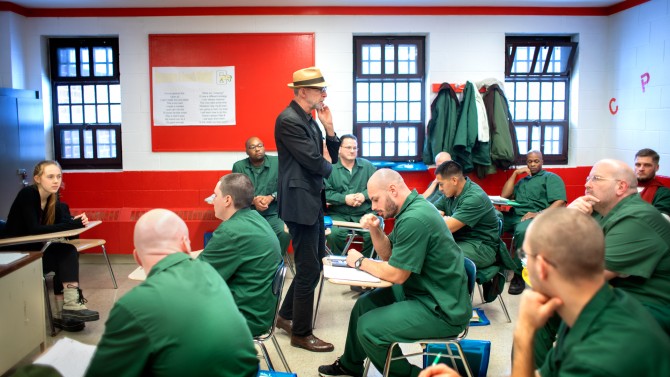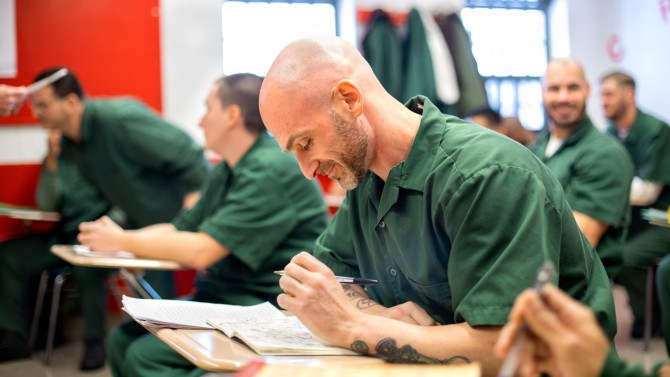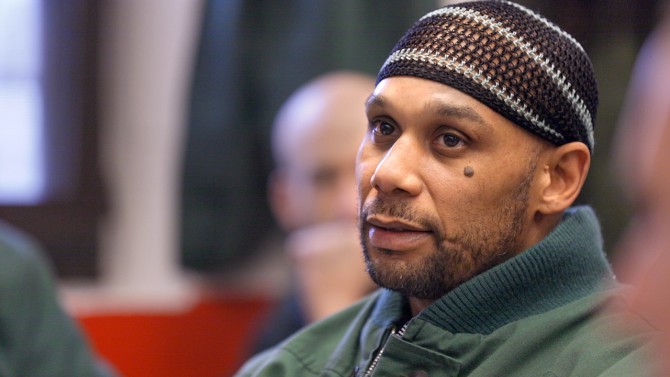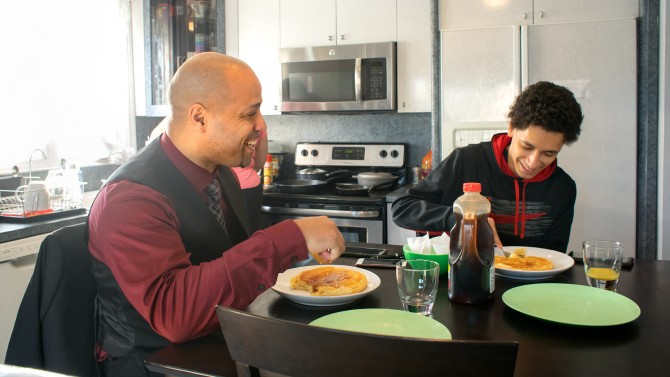‘Making the turn’: from inmate to scholar
By Susan Kelley
It is 4 p.m., and Darryl Epps has just put in a full day at work. Yet his day is only half over.
Meticulously groomed with a pencil-thin mustache and goatee, smart suit and silver tie pin, the 41-year-old Epps leaves the Fortune Society in Harlem, where he connects people who are formerly incarcerated with housing and other services. He drives two hours home to Staten Island, listening to Christian contemporary music along the way. At night, he attends classes at the College of Staten Island with his 19-year-old son or studies until midnight. The next day, he’s up at 5 a.m. to do it all again.
The days are long, but that’s how he’ll achieve his goals of earning a master’s degree and starting a social services practice.
“Every day ... I think about where I’m at now,” Epps says. “Ten years ago ... I didn’t know if I would ever get out of prison. I didn't know there would be a place for me in society.”
Epps grew up in the “hyperviolent” housing projects of Sheepshead Bay, Brooklyn, where he and his younger brother Darnell endured a tough public school and their parents’ eventual divorce. Darnell dropped out of school in 10th grade. Darryl bounced in and out of juvenile detention. “It was a lifestyle I didn’t want,” Darryl says, “but I felt it was the only one that was open to me.”
“The poorest decision I ever made” is how he describes what happened March 8, 2000. Darnell recounted it in a New York Times op-ed: “I accompanied Darryl to an encounter with a gang member who, days earlier, had sexually assaulted Darryl’s wife. We were both armed. Rather than report the assault, we set out for a confrontation. Within seconds, the situation escalated and Darryl fired several shots in a struggle for the gun, wounding the gang member and himself. Darryl and I survived. The gang member did not.”
They were sentenced to 17½ years to life. Darnell was 20; Darryl was 21, and his son was 5 months old. The brothers were taken to Five Points Correctional Facility, a maximum-security prison in Romulus, in central New York. “I was filled with a lot of shame, a lot of guilt, a lot of remorse and regret,” Darryl says.
Sixteen years later, they applied to the Cornell Prison Education Program, which gives incarcerated men the chance to earn an associate degree from Cayuga Community College, part of the State University of New York; qualified students are selected to pursue a Certificate in Liberal Arts from Cornell. The Ivy League’s largest prison education program, CPEP has educated more than 675 men incarcerated in New York prisons.
Darryl had always wanted to go to college, he says. “Even though I was incarcerated, this was my opportunity.”
“The college program provides the same benefit that education does to the outside community,” says Gerard Jones, superintendent of the Cayuga Correctional Facility in Moravia, New York, one of four CPEP prisons. “People are bettering themselves and preparing for their next stage in life.”
That preparation translates into real taxpayer savings. Nationwide, prison education reduces recidivism by 43%, saving taxpayers $4 for every $1 invested, according to a 2013 Rand Corp. study. New York’s correctional system, the third-largest in the nation, houses 47,000 inmates at an annual cost of $60,000 each.
CPEP saves taxpayer dollars in two ways: through early release and by reducing recidivism. Over the past five years, 32 students have been released six months early thanks to their CPEP participation, saving taxpayers $2.2 million in incarceration costs; none of those men have returned to prison, saving additional millions.
Darryl and Darnell worried they wouldn’t get into the program. Most applicants do not meet the requirements and do not pass the entrance exams; in 2016, when the Epps brothers applied, only 3% of the men at Five Points were admitted.
The brothers were in the cell they shared when a guard delivered their acceptance letters.
“It meant the world to me,” Darryl says. “I understood how important it was to be in an environment that cultivates learning and prepares you through discipline and holding yourself accountable.
“Without that, I was stuck.”

Professor Joe Margulies interacts with his students at Cayuga Correctional Facility in Moravia, New York;
teaching assistant Hailey Shapiro ’22, left, looks on.
‘Making the turn’
On a recent December afternoon, 50 miles east of Darryl’s former cellblock, a river of men wearing dark green uniforms coursed through Cayuga Correctional Facility’s education wing. Most headed to vocational and GED certificate classes; nationwide, 30% of people in prison lack a high school diploma – more than twice the percentage for U.S. households (14%), according to a 2014 study by the National Center for Education Statistics.
Fifteen men representing the most accomplished CPEP students walked into a bare-bones classroom painted Cornell red and white. Most had already earned an associate degree; in May, they will be the second cohort awarded Cornell’s Certificate in Liberal Arts, which launched in 2017.
The certificate is the latest development in the program, which began in 2010, after Mary Katzenstein, the Stephen and Evalyn Milman Professor of America Studies Emerita, was awarded a grant from the Sunshine Lady Foundation. Two years later, CPEP students earned the first associate degrees.
“These guys have been told all their lives that they were worthless, that they were garbage,” says Joe Margulies ’82, professor of government in the College of Arts and Sciences and professor of law at Cornell Law School, who teaches CPEP classes in writing and law.
Incarcerated people often look back with astonishment and revulsion at what they did and who they were, Margulies says. Education enables them to take a candid, painfully clear-eyed look at their past and evaluate it, with the prospect of a different identity in their future.
“To become someone else takes extraordinary courage, determination and resilience,” he says. “This is what is happening in my classroom. We talk about it all the time. We call it ‘making the turn’ – away from one life toward another. This is the reconstruction of a different identity.”
Students in his writing class had been reading works including Martin Luther King Jr.’s “Letter From Birmingham Jail” and Maya Angelou’s “I Know Why the Caged Bird Sings.”
That December afternoon, they read their own essays aloud.
Darryl Miller’s humor-tinged “Bloody Water” drew on his drug-addicted mother’s decision to give him and his sister up for adoption. Citing James Baldwin’s “Notes of a Native Son,” he concluded that water is thicker than blood. “You’ve developed, as a writer, your own voice,” Margulies tells Miller. The students discussed how the deft use of humor can intensify a serious topic.
Lucas Whaley read “My Autumn of Letting Go,” about considering leaving the program. Classmates offered supportive comments, but some said his thesis was unclear.
Hearing that he missed the mark “feels like getting eviscerated,” Whaley says. “But learning to deal with disappointment and use it to become better and stronger and more astute – I wouldn’t trade that for feeling better.”
The program teaches students not what to think, but how to think, he says. In prison, people segregate themselves by race, religion or neighborhood. In class, they mix. “It forces you to broaden your horizons and your perspective,” Whaley says. “That’s the first step to learning how to think things through, [realizing] that there are other viewpoints. They are as valid as yours.”
James Tyler read from his essay on taking responsibility for one’s actions. He noted that babies are unable to see color for the first six months of their lives; like them, he was indifferent to race until age 6. “It never occurred to me, while living in a neighborhood where kids and their parents were different shades of brown, that my lightness and my mother’s whiteness was anything but normal, that the disparity between our complexions could relegate me to limbo between societies, left with no option but to fight for access into the ethnicity stamped on my birth certificate,” he read. “All of a sudden I was a white boy, an outsider.” His piece prompted a robust discussion, in which his classmates debated the extent to which their incarcerations are the result of their poor decisions versus their environments.
CPEP students have “a thirst to think deeply, to learn intense and important information,” says Jamila Michener, assistant professor of government in A&S, who teaches public policy. “I can’t think of a better way to use Cornell’s prestige, prominence, power and resources than to help people in our society who may have done bad things – but who have certainly also had very difficult lives – move forward with dignity,” says Michener.
Darryl Epps was most influenced by Stefan Zweig’s “Virata or The Eyes of the Undying Brother,” which he read in a German philosophy class. In the short story, a warrior kills the general of an invading army. Afterward, he lifts his dead enemy’s visor and sees his own brother. “What I learned from that work was the importance of empathy … and your social responsibility to the rest of society,” he says.
He excelled academically because he didn’t want to disappoint himself or his son, who was 16 and living with his mother 250 miles away, in Brooklyn. Through phone calls, letters and occasional visits, Darryl shared with him medieval concepts of masculinity, the quadratic equation, Plato’s “The Allegory of the Cave.”
“I shed a lot of baggage, a lot of bad habits and impulsive behaviors that led to my incarceration,” Epps says. “I worked on developing better social skills and emotional skills to cope with things.”
Darryl and Darnell were paroled in 2017, six months early for their CPEP participation, after serving their minimum sentence. Darryl was two classes shy of an associate degree when he applied for a job at the Fortune Society, which supports formerly incarcerated people as they re-enter society. The position required the degree.
But because he had so many credits as well as CPEP letters of recommendation, he got the job – and subsequently finished the degree. His CPEP education, Epps says, “provided me with academic credibility and moral credibility in my community and with my employers and my family.”
“I could see him going really far,” says his supervisor, Gwendolyn Bonhomme-Padmore. “Clients are calling me constantly stating how much of a treasure he is.”
Upstate, in Rochester, Dedric Chislum’s associate degree and Cornell certificate landed him a job at JIT Machining within a week of his release. “My supervisor said: ‘I was surprised that you graduated from college. And the way you were able to express yourself made me willing to take a chance on you,’” Chislum says.
With CPEP credits, Darryl’s brother, Darnell, was accepted at Cornell. Now a senior majoring in government, he plans to attend law school.
A powerful investment
Given the high demand for classes, the program’s biggest challenge is funding, says CPEP director Rob Scott. Cornell provides the program’s offices on campus, allowing CPEP to recruit faculty and graduate student instructors and undergraduate volunteers, and waives tuition for Cornell courses through the School of Continuing Education. Grants and donations fund the rest of the operations, but the continuity of these sources is uncertain year to year.
Scott hopes the New York State Legislature will rescind a 1995 law that banned financial aid for incarcerated people. Without the stability of state financial aid, New York's college-in-prison programs cannot expand to provide education at the scale of mass incarceration.
“The day these people get out of prison, they’re eligible for financial aid,” Scott says. “The only time they can’t go to college is when they’re sitting still for many years.” In 2018, New York spent $2.84 billion on corrections and zero for college in prison, he says. “We’re talking about a very small cost for a very big impact.”
Cornell students, too, are learning inside the prison walls; CPEP has received grants through the Office of Engagement Initiatives, which supports Cornellians effecting positive change through community-engaged learning.
Graduate students and Cornell Law School students – 32 during the fall semester – volunteer as instructors for most CPEP classes. (Faculty teach certificate classes.) About 60 Cornell undergraduates volunteer annually as tutors and teaching assistants.
They include Hailey Shapiro ’22, a sophomore majoring in government and international relations who volunteered as a teaching assistant in Margulies’ writing class. “Oftentimes, I felt I deeply understood an assigned reading before class but then quickly realized my limited perspective when I got to class,” Shapiro says. “Our class had incredibly diverse perspectives, and I was constantly inspired by the profound concepts that students openly shared.” The experience has changed her academic trajectory; she now plans to go into criminal justice when she graduates.
There’s an even stronger societal argument for funding higher ed in prison, Margulies says: Almost everyone incarcerated in New York will be released eventually. “So the only question is, do you want them better equipped to participate in the all levels in which society engages? Or do you want them less prepared?
“These guys lack some skills, but they are exceedingly bright," Margulies says. "When we develop those skills, they become capable of being extraordinary contributors to the rippling universe of people that they are connected to. ... They are better fathers, they are better husbands and partners.”
Many CPEP students say a prime motivator is seeing how their commitment to learning inspires their children, nieces and brothers, says Jan Zeserson, courtesy lecturer and longtime CPEP faculty member. “Many of these guys never thought about going to college. And now they use their phone time to share assignments with their kids.”
‘That’s not me, bro’
Darryl and his son, Darryl III, a sophomore at the College of Staten Island who goes by “D,” are talking about their upcoming semester over a breakfast of pancakes and bacon. Darryl will take four classes; D, who is leaning toward a major in engineering or medical biology, will take five.
For most of his life, D only knew his father in prison. Every other month, he and his grandmother would leave Staten Island at 2 a.m. to drive six hours upstate for daylong visits. He was 17 when his father was released.
“Despite the mental toll it did take, I still have him. I have friends who just don’t have their dads at all,” D says. “I count my blessings.”
He has always looked to his uncle and father as academic models. He’s had to make decisions along the way. In middle school, his best friend joined a gang. “Yeah, that’s not me, bro,” D recalls telling him. In high school, he surrounded himself with a different crew; many are now in college, he says. “We’re all just ambitious and focused.”
In his college essay, D wrote about refusing to become a statistic; children whose parents are incarcerated face higher odds of entering the criminal justice system themselves. He doesn’t see himself falling into that category, he says, thanks to his father’s example.
“Every time school was hard, I used to always think, if he’s doing well in that situation, I can definitely do it,” D says. “I have all the opportunity, you know what I’m saying? I’m not going to let it go to waste.”
Media Contact
Get Cornell news delivered right to your inbox.
Subscribe





